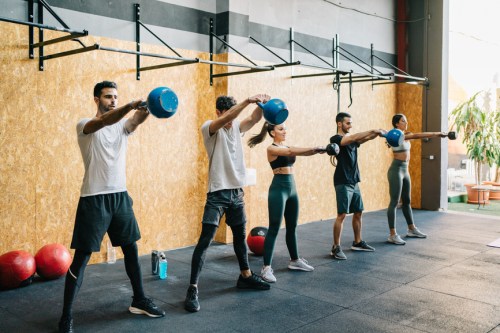We’ve come so far since the height of the pandemic, when restaurants, theaters, and even gyms shut down. And yet, so much is still unknown. Nevertheless, once doors to our favorite establishments reopened and COVID-19 vaccines and boosters became readily available in mid-2021, many people began to feel like a weight had finally been lifted. And, as such, a lot of people started booking travel, visiting loved ones, going out to restaurants and bars, and—at last—returning to the gym. But, living in the age of variants like Omicron—one of the newest and most transmissible variants of COVID-19—we can’t help but wonder: Are gyms safe?
Experts in This Article
As president and chief science officer, Cedric X. Bryant, Ph.D., FACSM, stewards ACE’s development and delivery of exercise-science and behavior-change education in ways that are engaging and compelling, recruits more people to become exercise professionals and health coaches, and equips them for growth in their respective fields. Bryant leads ACE’s exploration of how their science-based programs and interventions appropriately integrate into healthcare and public health. Bryant also represents ACE by serving on the advisory boards and committees for several highly respected public health organizations including the World Health Organization (WHO), Centers for Disease Control and Prevention (CDC), and National Academy of Sciences, Engineering, and Medicine (NASEM).
microbiologist and author of The Germ Files
Covid-19 Confusion
It’s admittedly confusing to figure out what’s “safe” in the current reality given how much (and how often) the Centers for Disease Control and Prevention (CDC) has changed recommendations for not only isolation but separation, too. After all, what began as a mandatory 14-day isolation period has since been reduced to just five days (so long as symptoms are improving), followed by five days of masked distance. (Of course, this switch led many people to question the initial science behind the recommendations, prompting many to believe that the reduction is more so about capitalism than general well-being.)
Running the Risk
“The gym is up there in places where you would have the highest risk for the spread of the Coronavirus,” Jason Tetro, microbiologist and author of The Germ Files, told Well+Good back in March 2020. “You have a lot of people who are exerting themselves, which means they’re breathing a lot and may be sputtering and coughing. And if these people are starting to get sick or develop the infection, there’s a likelihood that they may be spreading that from their lungs into the environment around them.”
Although COVID-19 has evolved since Tetro shared that advice, the sentiment still stands—only now, thanks to modern medicine, the illness isn’t nearly as conspicuous.
“The concern with the Omicron variant surge and indoor gym participation is that the variant can result in many asymptomatic but potentially contagious people working out near one another,” says American Council on Exercise president and chief science officer Cedric X. Bryant, PhD.
This means that, even though many gyms have taken precautions (like deep cleaning, taking temperatures, requiring members to wear masks, and, in some situations, even requiring vaccination) and are encouraging members to stay home if they’re feeling sick, the virus can still spread. That’s because, as the CDC points out, the virus spreads “when an infected person breathes out droplets and very small particles that contain the virus.” These droplets can land in the mouths or noses of people nearby, or possibly be inhaled into their lungs. In some instances, those droplets can land on surfaces, too, which can then be transferred by touch—that’s why one of the main messages of Covid-19 prevention has been to keep your hands away from your eyes, mouth, and face as a whole.
Is it actually safe to go to the gym?
At this point, anyone reading this would likely conclude that going to the gym during Covid-19 isn’t a good idea. But why, then, are so many gyms open, and, better yet, why have so many relaxed their policies? Vaccines and boosters drastically reduce the risk of serious symptoms associated with Covid-19, which is ultimately making people feel safeguarded (or invincible, depending on how you want to look at it) against the virus.
Still, Dr. Bryant doesn’t recommend relying on a brick and mortar for your exercise needs during the pandemic.
“It’s safest to work out outdoors,” he says. That said, if avoiding the gym feels unavoidable (not to mention downright depressing), he says the best thing you can do for yourself and for others is get vaccinated and wear a mask, and if possible, to only go during less busy times of the day. Additionally, he recommends being aware of your surroundings while working out.
“Different sections of the gym offer varying degrees of risk,” he explains. “The weight room or resistance training area typically is the least risky area since users can spread out and maintain an appropriate distance from other people.”
As for the riskiest form of indoor exercise while Covid-19 is running rampant? As much as it pains us to say, classes like Orangetheory, SoulCycle, and Barry’s Bootcamp. “Indoor group exercise classes are typically the riskiest area since you have a situation where people are close to each other and breathing heavily,” says Dr. Bryant.
The Takeaway
While gym goers who are vaccinated and boosted can feel reasonably comfortable working out indoors, Dr. Bryant says that it’s important that mitigation efforts are still in place, such as wearing a mask (preferably a well-fitting N95), physical distancing, good ventilation, and hand washing, among others.
Sign Up for Our Daily Newsletter
Get all the latest in wellness, trends, food, fitness, beauty, and more delivered right to your inbox.
Got it, you've been added to our email list.











